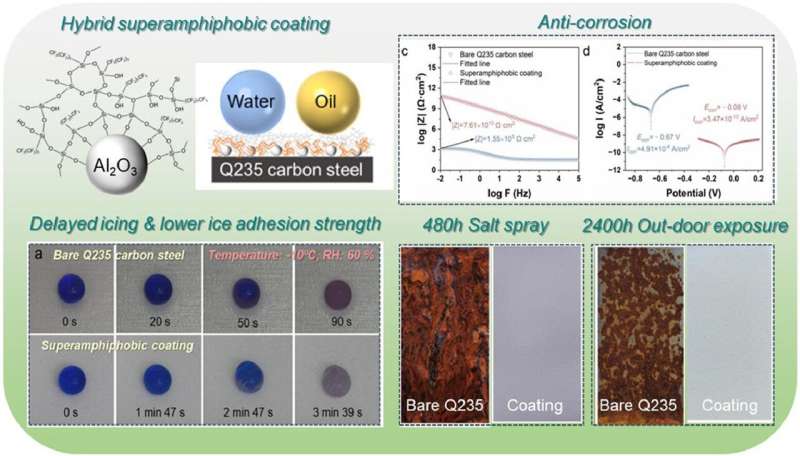This article has been reviewed according to Science X's editorial process and policies. Editors have highlighted the following attributes while ensuring the content's credibility:
fact-checked
trusted source
proofread
Researchers develop hybrid superamphiphobic anti-corrosion and anti-icing coating

Corrosion and failure of metal materials has been a problem that researchers and engineers are eager to solve. Inspired by the lotus effect, biomimetic superhydrophobic materials with typical non-wetting properties at the interface have shown great potential in the field of corrosion protection.
Although the anti-corrosion function of superhydrophobic materials has been confirmed by researchers at home and abroad, there are still many unresolved challenges in the process of transitioning from the laboratory to practical applications.
A research team led by Prof. Zhang Binbin from the Institute of Oceanology of the Chinese Academy of Sciences reported an organic–inorganic hybrid superamphiphobic coating with integrated functionalities of liquid repellency, self-cleaning, anti-corrosion, and anti-icing.
The study is published in the Journal of Materials Science & Technology.
According to the researchers, the developed coating exhibits both superhydrophobic and superoleophobic properties and shows excellent repellency to low surface tension liquids such as water, glycerol, ethylene glycol, and peanut oil, with sliding angles all less than 7°.
The corrosion resistance of the coatings was extensively evaluated using electrochemical impedance spectroscopy, Tafel polarization, salt spray testing, and outdoor atmospheric exposure, respectively. The results showed that the charge transfer resistance and low-frequency modulus of the coating increased by 7–8 orders of magnitude, enduring 480 hours of neutral salt spray and 2,400 hours of atmospheric exposure, demonstrating significant long-term anti-corrosion potential.
In addition to significantly improved corrosion resistance, the coatings also demonstrated their functional integration capabilities in self-cleaning, delayed icing, lossless liquid transport, and substrate applicability.
The uniform dispersion of functionalized Al2O3 nanoparticles in the coatings provides important assurance for the ultimate realization of the coatings' multifunctional integration properties.
"We firmly believe that the continuous improvement of functional integration and long-term stability will remain the focus of future research in this field," said Prof. Zhang, first and corresponding author of the study.
More information: Binbin Zhang et al, Hybrid superamphiphobic anti-corrosion coating with integrated functionalities of liquid repellency, self-cleaning, and anti-icing, Journal of Materials Science & Technology (2023). DOI: 10.1016/j.jmst.2023.10.042
Provided by Chinese Academy of Sciences




















